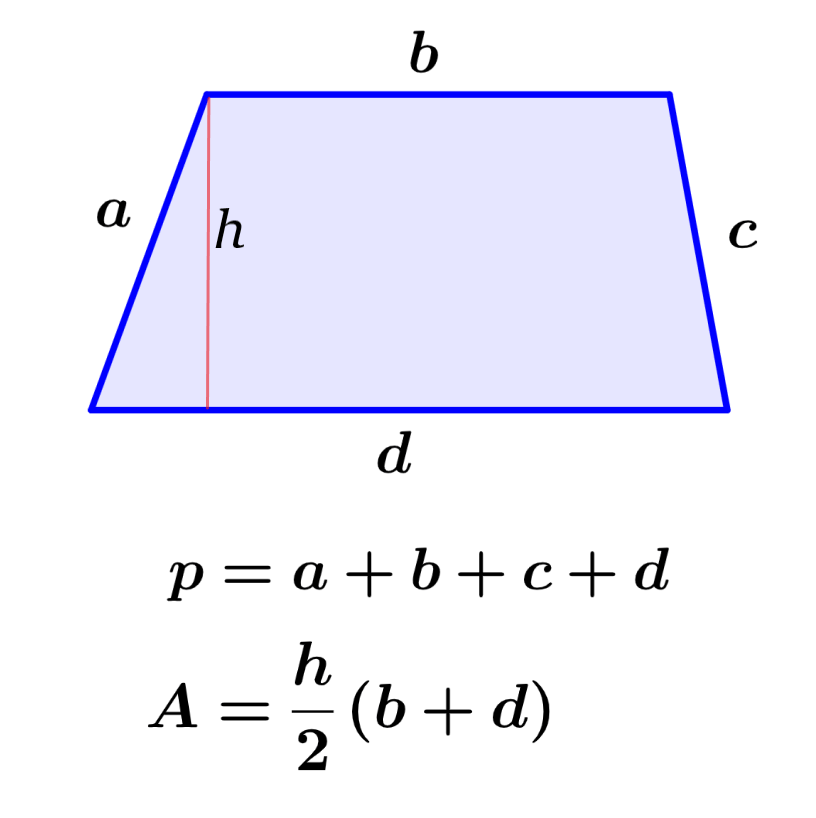The perimeter of a trapezoid is the total length of the outline of the trapezoid. On the other hand, the area is a measure of the space occupied by the trapezoid. We can find the perimeter of a trapezoid by adding the lengths of all its sides, and we can find its area by adding its bases, multiplying by its height, and dividing by 2.
In this article, we will learn all about the perimeter and area of a trapezoid. We will explore their formulas and use them to solve some practice problems.
How to find the perimeter of a trapezoid?
To calculate the perimeter of a trapezoid, we have to add the length of all its sides. Therefore, the formula for the perimeter of a trapezoid is:
| $latex p=a+b+c+d$ |
where, “a, b, c, d” represent the lengths of the sides of the trapezoid.

Perimeter of an isosceles trapezoid
In an isosceles trapezoid, two of its sides have the same length, so we can calculate its perimeter with the following formula:
| $latex p=a+b+2c$ |
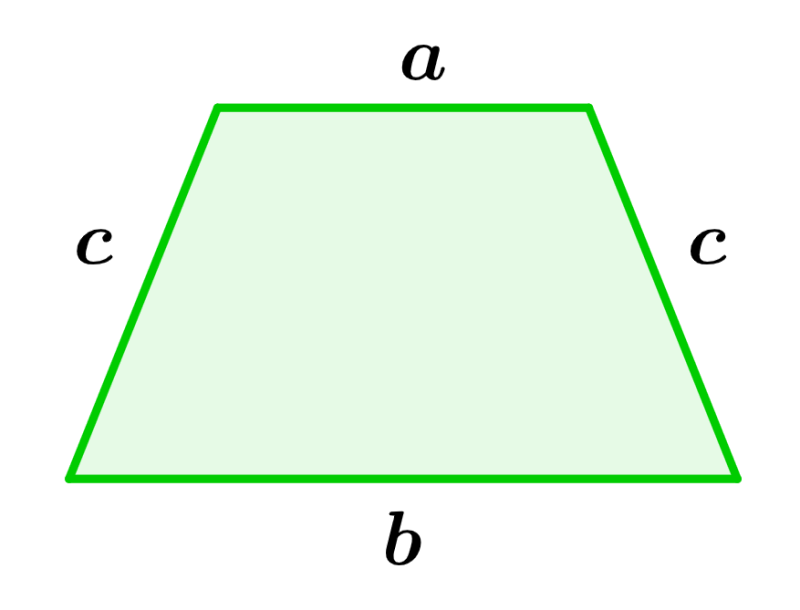
How to find the area of a trapezoid?
To find the area of a trapezoid, we have to add the lengths of its bases. We then multiply that sum by the height of the trapezoid and divide the result by 2. This means that the formula for the area of the trapezoid is:
| $latex A=\frac{(b_{1}+b_{2})h}{2}$ |
where,
- $latex b_{1}=$ base 1 of trapezoid
- $latex b_{2}=$ base 2 of trapezoid
- $latex h=$ height of trapezoid
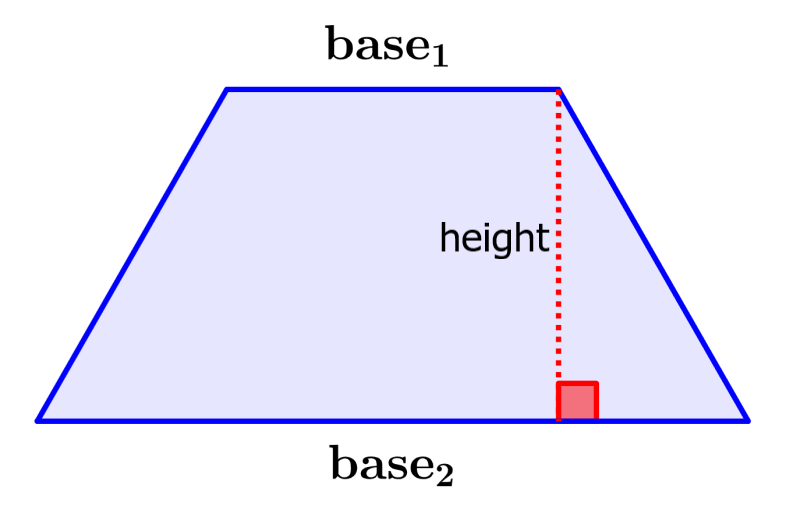
Proof of the formula for the area of a trapezoid
We can prove the formula for the area of a trapezoid using the following diagram:
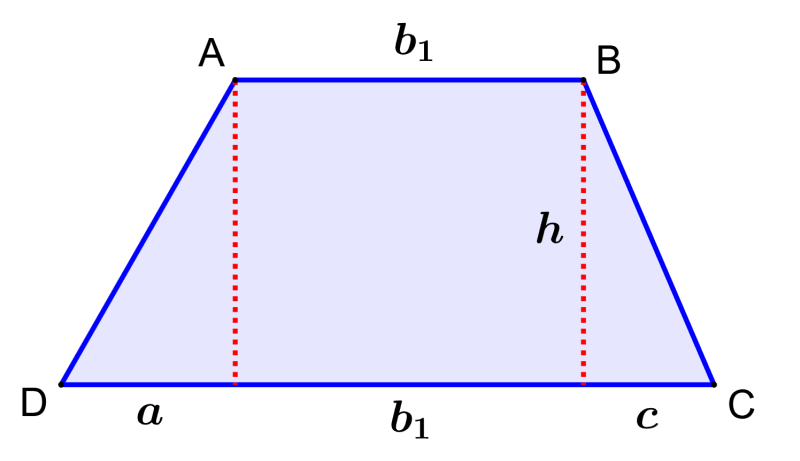
The trapezoid can be divided into two right triangles and one rectangle. The area of the trapezoid is equal to the sum of the areas of the two triangles and the area of the rectangle. Therefore, we have to:
area of trapezoid = area of triangle 1 + area of rectangle + area of triangle 2
$$A=\frac{ah}{2}+b_{1}h+\frac{ch}{2}$$
$$A=\frac{ah+2b_{1}h+ch}{2}$$
Rearranging the terms and simplifying, we have:
$$A=\frac{h}{2}(b_{1}+(a+b_{1}+c))$$
Now, let’s use $latex b_{2}$ to represent the longer base of the trapezoid:
$latex b_{2}=a+b_{1}+c$
Substituting this into the above equation, we have:
$latex A=\frac{h}{2}(b_{1}+b_{2})$
Perimeter and area of a trapezoid – Examples with answers
EXAMPLE 1
If a trapezoid has sides with lengths 6 inches, 8 inches, 5 inches, and 7 inches, what is its perimeter?
Solution
We use the formula for the perimeter of a trapezoid with the given lengths:
$latex p=a+b+c+d$
$latex p=6+8+5+7$
$latex p=26$
The perimeter of the trapezoid is equal to 26 in.
EXAMPLE 2
What is the area of a trapezoid that has bases with lengths 8 feet and 12 feet and a height of 10 feet?
Solution
We have the following information:
- Base 1, $latex b_{1}=8$ ft
- Base 2, $latex b_{2}=12$ ft
- Height, $latex h=10$ ft
Using the formula for the area, we have:
$$A=\frac{(b_{1}+b_{2})h}{2}$$
$$=\frac{(8+12)10}{2}$$
$$=\frac{(20)(10)}{2}$$
$$=\frac{200}{2}$$
$latex A=100$
The area of the trapezoid is equal to 100 ft².
EXAMPLE 3
Find the perimeter of a trapezoid that has side lengths of 12 inches, 14 inches, 7 inches, and 9 inches.
Solution
Plugging the given lengths into the perimeter formula, we have:
$latex p=a+b+c+d$
$latex p=12+14+7+9$
$latex p=42$
The perimeter of the trapezoid is equal to 42 in.
EXAMPLE 4
Find the area of a trapezoid that has bases with lengths of 11 yards and 15 yards and a height of 12 yards.
Solution
We have the following:
- Base 1, $latex b_{1}=11$ yd
- Base 2, $latex b_{2}=15$ yd
- Height, $latex h=12$ yd
Applying these values in the formula for the area, we have:
$$A=\frac{(b_{1}+b_{2})h}{2}$$
$$=\frac{(11+15)12}{2}$$
$$=\frac{(26)(12)}{2}$$
$$ =\frac{312}{2}$$
$latex A=156$
The area of the trapezoid is equal to 156 yd².
EXAMPLE 5
An isosceles trapezoid has two parallel sides that are 11 inches and 13 inches long. If the lateral sides of the trapezoid measure 9 inches, what is its perimeter?
Solution
An isosceles trapezoid has two equal sides, that is, we have c=9 in the following formula:
$latex p=a+b+2c$
$latex p=11+13+2(9)$
$latex p=24+18$
$latex p=42$
The perimeter of the trapezoid is equal to 42 in.
EXAMPLE 6
Find the height of a trapezoid that has an area of 200 in², a base of 9 inches, and the other base of 11 inches.
Solution
We have the following:
- Area, $latex A=200$ in²
- Base 1, $latex b_{1}=9$ in
- Base 2, $latex b_{2}=11$ in
In this case, we have to use the formula for the area and solve for the height:
$$A=\frac{(b_{1}+b_{2})h}{2}$$
$$200=\frac{(9+11)h}{2}$$
$latex 400=(9+11)h$
$latex 400=20h$
$latex h=20$
The height of the trapezoid is equal to 20 in.
EXAMPLE 7
A trapezoid has a perimeter of 86 feet and has three sides that are 21 feet, 23 feet, and 25 feet long. Determine the length of the fourth side.
Solution
In this case, we have to use the formula for the perimeter with the given perimeter and lengths, and we are going to solve for the fourth side:
$latex p=a+b+c+d$
$latex 86=21+23+25+d$
$latex d=86-21-23-25$
$latex d=17$
The length of the fourth side is 17 ft.
EXAMPLE 8
If a trapezoid has an area of 240 yd², a base length of 11 yd, and the other base length of 13 yd, find its height.
Solution
We have the following:
- Area, $latex A=240$ yd²
- Base 1, $latex b_{1}=11$ yd
- Base 2, $latex b_{2}=13$ yd
Therefore, we use the formula for the area of a trapezoid and solve for h:
$$A=\frac{(b_{1}+b_{2})h}{2}$$
$$240=\frac{(11+13)h}{2}$$
$latex 480=(11+13)h$
$latex 480=24h$
$latex h=20$
The height of the trapezoid is 20 yd.
EXAMPLE 9
Find the length of the lateral sides of an isosceles trapezoid that has a perimeter of 64 feet and the lengths of its parallel sides are 13 feet and 17 feet long.
Solution
We can represent the length of the lateral sides with c. Therefore, we plug the given values into the formula for the perimeter and solve for c:
$latex p=a+b+2c$
$latex 64=13+17+2c$
$latex 64=30+2c$
$latex 34=2c$
$latex c=17$
The length of one of the lateral sides is 17 ft.
EXAMPLE 10
Find the area of the following trapezoid.
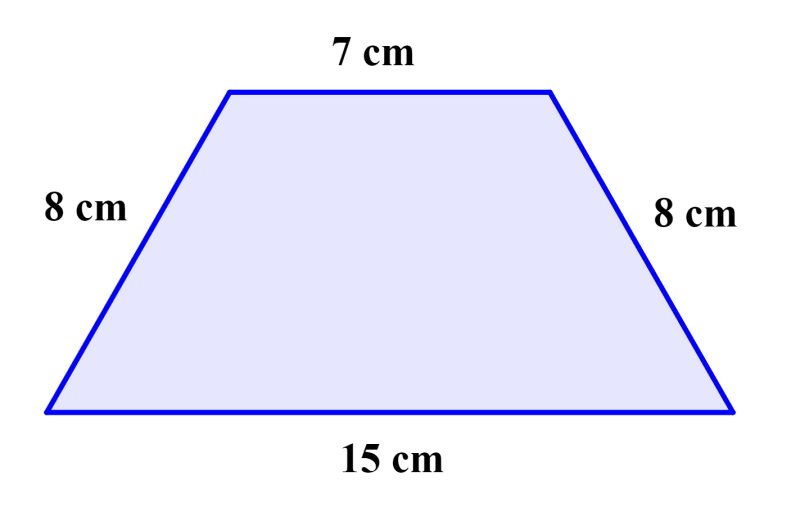
Solution
This is an isosceles trapezoid that has two equal lateral sides. Therefore, let’s calculate the height of the trapezoid as shown in the diagram below.
We get the bases of the two triangles by subtracting 7 from 15 and dividing by 2.
⇒ $latex \frac{15-7}{2}=4$ cm
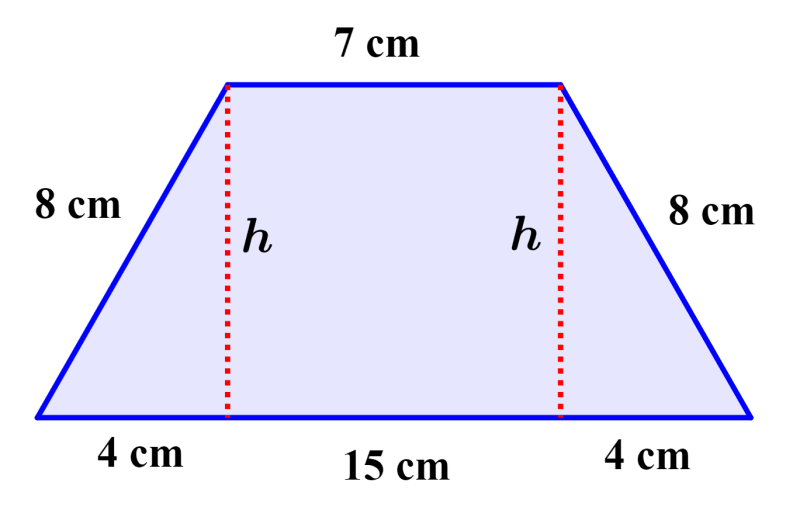
Using the Pythagorean theorem, we can calculate the height:
$latex {{8}^2}={{h}^2}+{{4}^2}$
$latex 64={{h}^2}+16$
$latex {{h}^2}=48$
$latex h=6.93$ cm
Now, we can use the height and base to calculate the area of the trapezoid:
$$A=\frac{(b_{1}+b_{2})h}{2}$$
$$=\frac{(15+7)6.93}{2}$$
$$=\frac{(22)(6.93)}{2}$$
$latex A=76.23$
The area of the trapezoid is 76.23 cm².
Perimeter and area of a trapezoid – Practice problems
See also
Interested in learning more about the perimeter and area of geometric figures? Take a look at these pages:

